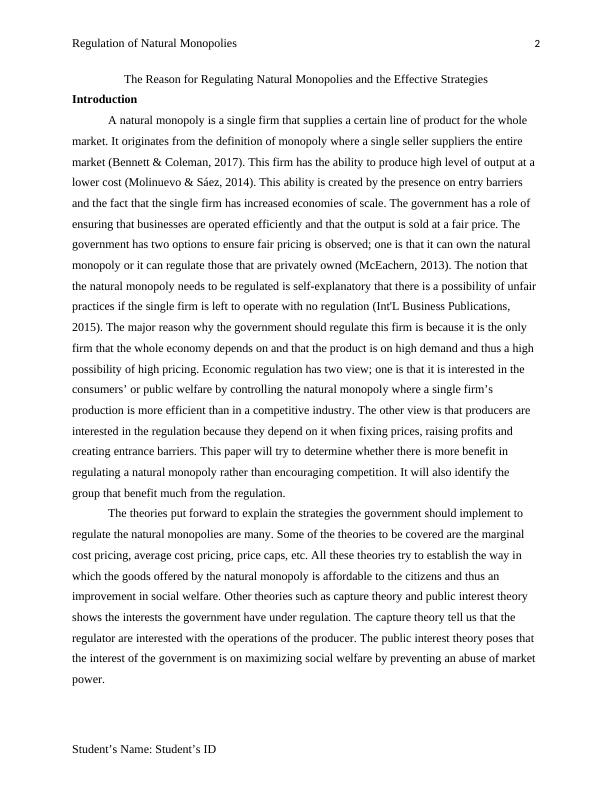Regulation of Natural Monopolies
9 Pages2648 Words267 Views
Added on 2019-11-26
Regulation of Natural Monopolies
Added on 2019-11-26
ShareRelated Documents
Running Head: Regulation of Natural MonopoliesThe Reason for Regulating Natural Monopolies and the Effective StrategiesStudent NameInstitutional AffiliationCourse/NumberInstructor NameDue Date

Regulation of Natural Monopolies2The Reason for Regulating Natural Monopolies and the Effective StrategiesIntroductionA natural monopoly is a single firm that supplies a certain line of product for the whole market. It originates from the definition of monopoly where a single seller suppliers the entire market (Bennett & Coleman, 2017). This firm has the ability to produce high level of output at a lower cost (Molinuevo & Sáez, 2014). This ability is created by the presence on entry barriers and the fact that the single firm has increased economies of scale. The government has a role of ensuring that businesses are operated efficiently and that the output is sold at a fair price. The government has two options to ensure fair pricing is observed; one is that it can own the natural monopoly or it can regulate those that are privately owned (McEachern, 2013). The notion that the natural monopoly needs to be regulated is self-explanatory that there is a possibility of unfair practices if the single firm is left to operate with no regulation (Int'L Business Publications, 2015). The major reason why the government should regulate this firm is because it is the only firm that the whole economy depends on and that the product is on high demand and thus a high possibility of high pricing. Economic regulation has two view; one is that it is interested in the consumers’ or public welfare by controlling the natural monopoly where a single firm’s production is more efficient than in a competitive industry. The other view is that producers are interested in the regulation because they depend on it when fixing prices, raising profits and creating entrance barriers. This paper will try to determine whether there is more benefit in regulating a natural monopoly rather than encouraging competition. It will also identify the group that benefit much from the regulation.The theories put forward to explain the strategies the government should implement to regulate the natural monopolies are many. Some of the theories to be covered are the marginal cost pricing, average cost pricing, price caps, etc. All these theories try to establish the way in which the goods offered by the natural monopoly is affordable to the citizens and thus an improvement in social welfare. Other theories such as capture theory and public interest theory shows the interests the government have under regulation. The capture theory tell us that the regulator are interested with the operations of the producer. The public interest theory poses that the interest of the government is on maximizing social welfare by preventing an abuse of market power.Student’s Name: Student’s ID

Regulation of Natural Monopolies3AnalysisPettinger (2012) gave several types of natural monopolies and argued that it is more efficient for a single firm to supply the whole economy than a multiple of firms. The reason he posed out is that the fixed costs for the single firm is high and that there is a huge capital requirement to initiate the distribution of the resources supplied by a natural monopoly. He argued that the average cost for the multiple firms would be higher compared to the single firm because this firm already has significant economies of scale. Some of the examples given includetap water; laying of pipes to supply to the entire economy is capital intensive, electricity; its distribution networks are very expensive to initiate, railway transportation; the cost of laying the rails is very high and thus not practically available for competition, the gas distribution and postal services, etc. Economies of scale is the advantage of reduced costs of production enjoyed when a natural monopoly firm produced high level of output as shown in the image below.Fig: Natural monopoly’s economies of scale Cost ACaACcACbLRACDQaQbQuantityThe economies of scale creates a rationale for the government to allow the operation of a natural monopoly rather than allowing competition in this industry. The Average cost of producing Qa units by a multiple of producers is Aca, whereas the cost for producing the higher level quantity Qb by the same natural monopoly is ACb. If a single firm is able to produce quantity Qb at a cost ACB, let’s assume that there was entrant of another firm in this industry; if Qb is the maximum level of demand, then it means that the two firms will produce the same Student’s Name: Student’s ID

End of preview
Want to access all the pages? Upload your documents or become a member.
Related Documents
Natural Monopoly Pricing assignmentlg...
|9
|2714
|40
Essay on Natural Monopoly: Regulationslg...
|13
|2623
|62
Barriers to Entry in Natural Monopoly Marketslg...
|13
|2717
|192
Natural Monopoly in Australialg...
|8
|1691
|67
Assignment Regulation Of Monopolieslg...
|12
|2241
|158
Monopoly Power and Market Failure: A Case Study of Qantaslg...
|11
|2374
|182
